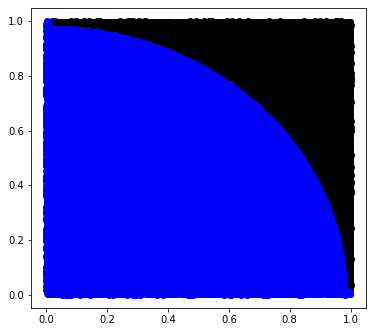Ipython
ipython中的快捷键
| 快捷键 | 说明 |
|---|---|
Ctrl+A |
移动光标到最前面 |
Ctrl+E |
移动光标到最末尾 |
Ctrl+U |
删除光标前的内容 |
Ctrl+K |
删除光标后的内容 |
Ctrl+L |
消除显示内容 |
Crrl+C |
中断当前的脚本运行 |
查询命令空间中所有的函数和对象
In [2]: np.random.rand*? |
查询命令:??
In [4]: np.random.rand?? |
魔术命令
-
查看变量
%who``%whosIn [7]: whos
Variable Type Data/Info
-------------------------------
a ndarray 100x100: 10000 elems, type `float64`, 80000 bytes
msg str hello ipython
np module <module 'numpy' from '/ho<...>kages/numpy/__init__.py'>
In [8]: who
a msg np -
清空变量和库
%reset -
命令行运行
%run hello.py -
记录log文件
- 开始记录log:
%logstart - 停止记录log:
%logstop
- 开始记录log:
-
直接运行shell命令:
!In [21]: !ifconfig |grep "inet "
inet 地址:192.168.6.135 广播:192.168.6.255 掩码:255.255.255.0
inet 地址:127.0.0.1 掩码:255.0.0.0 -
重载函数:
from imp import reload# 原先的python函数,hello.py
def say_hello():
print("ipython is a bad tool")
# 调用查看:
# import hello
# hello.say_hello()
# 后修改为:
def say_hello():
print("ipython is a bad tool")
# 在此调用查看:
# from imp import reload
# reload(hello)
# hello.say_hello()
Jupyter-notebook教程
-
开启notebook:
ipython notebook -
快捷键
-
切换命令模式和编辑模式:
Ctrl+M- 运行当前Cell,并停留在当前Cell:
Ctrl+Enter - 运行当前Cell,并停留在下一Cell:
Shift+Enter - 在命令模式下:删除当前Cell:
DD - 转换为Markdown:
M - 转换为代码模式:
Y - 在当前cell上面插入代码块:
A - 在当前cell下面插入代码块:
B
- 运行当前Cell,并停留在当前Cell:
-
编辑模式:
Enter- 快速删除一行:
ctrl+D
- 快速删除一行:
-
Numpy 基础使用
-
Numpy默认将计算结果转换为
行向量 -
Numpy提供基本的统计功能,求和、求平均值、求方差
- 一维数组
In [5]: a = np.random.randint(1,5,6)
In [6]: a.sum()
Out[6]: 21
In [7]: a.mean()
Out[7]: 3.5
In [8]: a.std()
Out[8]: 0.7637626158259734
In [9]: a.min()
Out[9]: 2
In [10]: a.max()
Out[10]: 4
In [11]: a.argmin()
Out[11]: 0
In [13]: a.argmax()
Out[13]: 1
In [14]: print(a)
[2 4 4 4 3 4]- 二维数组或高维数组,通过
axis=0按行计算,axis=1按列计算
消除哪儿一维就选择对应的axis的序号
In [15]: b = np.random.randint(1,100,(6,4))
In [16]: print(b)
[[55 92 10 75]
[63 34 61 7]
[25 29 36 83]
[62 44 6 12]
[ 5 37 25 13]
[36 93 91 14]]
In [17]: b.sum()
Out[17]: 1008
In [18]: b.sum(axis=0).sum()
Out[18]: 1008
In [19]: b.sum(axis=1)
Out[19]: array([232, 165, 173, 124, 80, 234])
In [20]: b.std(axis=1)
Out[20]:
array([30.65126425, 22.85142228, 23.28492001, 23. , 12.12435565,
34.39840113])
In [21]: b.min(axis=1)
Out[21]: array([10, 7, 25, 6, 5, 14])-
添加一个维度
np.newaxisIn [1]: a = np.arange(4)
In [3]: a = np.arange(4)
In [4]: a.shape
Out[4]: (4,)
In [5]: b = a[:,np.newaxis]
In [6]: b.shape
Out[6]: (4, 1)
In [7]: c = a[np.newaxis,:]
In [8]: c.shape
Out[8]: (1, 4) -
判断两个矩阵是否相同:
().all()In [10]: a = np.array([1,2,3,4])
In [11]: b = np.array([2,3,4,5])
In [12]: a == b
Out[12]: array([False, False, False, False])
In [13]: (a ==b ).all()
Out[13]: False -
numpy的读写
- 保存为
.txt - 保存为numpy二进制文件
.npy
a = np.arange(15).reshape(3,5)
print(a)
[[ 0 1 2 3 4]
[ 5 6 7 8 9]
[10 11 12 13 14]]
np.savetxt("a.txt",a)
np.loadtxt("a.txt")
np.save("a.npy",a)
np.load("a.npy")查看对应的大小:
ls -lh
-rw-rw-r-- 1 jacky jacky 248 12月 18 17:04 a.npy
-rw-rw-r-- 1 jacky jacky 375 12月 18 17:04 a.txt - 保存为
-
Numpy 多项式拟合
- 根的求解
import numpy as np
p = np.poly1d([1,-4,3])
# 自变量取0的值
p(0)
# 多项式的根
p.roots
print(p.roots)
# 对应根值的y值是0
p(p.roots)
print(p(p.roots))
# 多项式的阶数
p.order
print(p.order)
# 多项式的系数
p.coeffs
print(p.coeffs)- 拟合
import numpy as np
import matplotlib.pyplot as plt
n_dots = 20
n_order = 3
x = np.linspace(0,1,n_dots)
# 真实的函数:y = sqrt(x) 再加上 0.2 的方差
y = np.sqrt(x) + 0.2 *np.random.rand()
# 用三次多项式拟合 y = sqrt(x) 函数
p = np.poly1d(np.polyfit(x,y,n_order))
# 输出三次拟合后的系数
print(p.coeffs)
# 绘制拟合权限
t = np.linspace(0,1,200)
plt.plot(x,y,'ro',t,p(t),'-') -
蒙特卡洛方法:计算值
import numpy as np
import matplotlib.pyplot as plt
n_dots = 100000
x = np.random.rand(n_dots)
y = np.random.rand(n_dots)
distance = np.sqrt(x ** 2 + y ** 2)
in_circle = distance[distance < 1]
Pi = 4 * float(len(in_circle)) / n_dots
print(Pi)
plt.plot(x[distance<1],y[distance<1],'bo',x[distance>=1],y[distance>=1],'ko')



